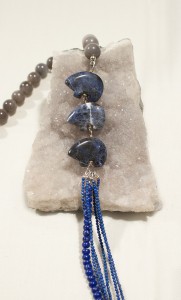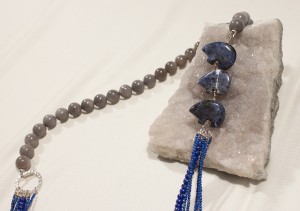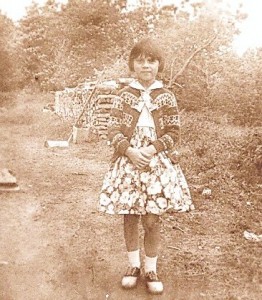Not the three bears of Goldilocks fame, the ones sitting in a cottage eating porridge, but

these three bears. They’re on are on a 36-inch long necklace bookkended by a strand of transluscent grey Moonstone and six strands of royal blue Lapis Lazuli in two sizes. The bears are Sodalite, a blue stone that is often mistaken for Lapis. The main difference – Sodalite rarely has the brassy gold pyrite flecks. But like Lapis, Sodalite has calcite which often shows in white streaks.
When I was designing this necklace, the sodalite bears seemed a natural companion to the lapis beads. During a visit (not intended to be a shopping trip) to the bead store, I found the beautiful moonstone that was an excellent complement to the blue stones. I wanted to give some freedom and movement to the bears so I decided to wire work them with sterling silver wire. The wire work and the large hammered sterling silver ring between the lapis and moonstone gives openness to the piece.

Sodalite
Did you know that Bancroft, Ontario, Canada is the most important commercial source of Sodalite? There are stories about a royal visit to Bancroft and the sodalite mines but discrepancies in the literature about who the royal was. Some say it was Princess Margaret while others say it was the Duke and Duchess of Cornwall (later King George V and Queen Mary) who visited Bancroft in 1901 as part of their cross-Canada tour. Most likely, it was the latter who visited, and they say the royals were so taken with the blue colour of the gemstone that they ordered Sodalite to decorate their residence, Marlborough House. The Princess Mine in Bancroft was named in honour of this visit.
Another interesting fact – Sodalite and Amethyst were in competition to become the official provincial mineral for Ontario. Amethyst won.
The blue variety of Sodalite is the most familiar but it can also be white, gray, purple or green. It is thought that sodalite is helpful for meditiation, and psychics believe the gem can facilitate natural intuition and psychic abilities. Sodalite is considered to be a lucky stone for writers in general and creative writers in particular.
Moonstone
Moonstone was named for its resemblance to the moon. In 1970, Moonstone became the official gem for Florida. State lawmakers decided to memorialize the “giant step for mankind” taken by astronauts Neil Armstrong and Buzz Aldrin when they walked on the moon on July 20, 1969. Even though moonstone isn’t found in Florida, the fact that Apollo 11 was launched from the Kennedy Space Centre was enough for the Florida legislature to name it their state gemstone.
The Romans believed Moonstone was formed from the light of the moon, and in the Orient, it was believed moonstones were rays of moonlight that had solidified. Moonstone comes in a variety of colours and shades from colourless to silvery-white, yellow to orange, green to gray, brown, peach, pink and a multi-coloured one called rainbow. Sri Lanka produces the highest quality moonstones. It is also found in Brazil, Myanmar, Mexico, Madagascar, India and Germany. Moonstone is thought to calm the emotions and enhance intuition and is also looked upon as a traveller’s stone, providing protection.
More on Bears
In the traditional Anishnawbe (Ojibway) Nation, there was a clan system, a framework of government designed to give strength and order to the Anishnawbe people. There were several original clans and everyone belonged to a clan. Each of these clans was given a function and amongst the seven, all aspects of life and living were covered. The Bear Clan had the responsibility of ensuring safety for the people, serving as the guardians or police force. They spent most of their time patrolling ir order to ward off any unwelcome visitors. Because of the large amount of time spent close to nature, the Bear Clan became familiar with plants and whose roots, leaves or barks could be used for medicine. They became known not just as the guardians but also as the healers or medicine people.
And Finally – Fashion and Voting
 Mixing prints is not just a recent fashion trend. I was about seven or eight in this photo, mixing a flowered print dress with what looks like an Icelandic print cardigan. And saddle shoes – remember them? And the pile of wood behind me? We grew up with a wood stove for both heat and cooking. I still shiver when I remember those winter mornings when I didn’t want to get out of bed because the house was icy cold. My mom and dad were early risers and they’d get the fires going in the kitchen and living room stoves, but it took the house a long while to warm up. You can imagine how ecstatic we all were when we finally got electricity. That was right around the same time that Status Indians in Canada were given the right to vote in federal elections. The right to vote was granted in 1960 when the Canadian Bill of Rights was enacted under the leadership of Prime Minister Diefenbacher.
Mixing prints is not just a recent fashion trend. I was about seven or eight in this photo, mixing a flowered print dress with what looks like an Icelandic print cardigan. And saddle shoes – remember them? And the pile of wood behind me? We grew up with a wood stove for both heat and cooking. I still shiver when I remember those winter mornings when I didn’t want to get out of bed because the house was icy cold. My mom and dad were early risers and they’d get the fires going in the kitchen and living room stoves, but it took the house a long while to warm up. You can imagine how ecstatic we all were when we finally got electricity. That was right around the same time that Status Indians in Canada were given the right to vote in federal elections. The right to vote was granted in 1960 when the Canadian Bill of Rights was enacted under the leadership of Prime Minister Diefenbacher.
Leave a Reply